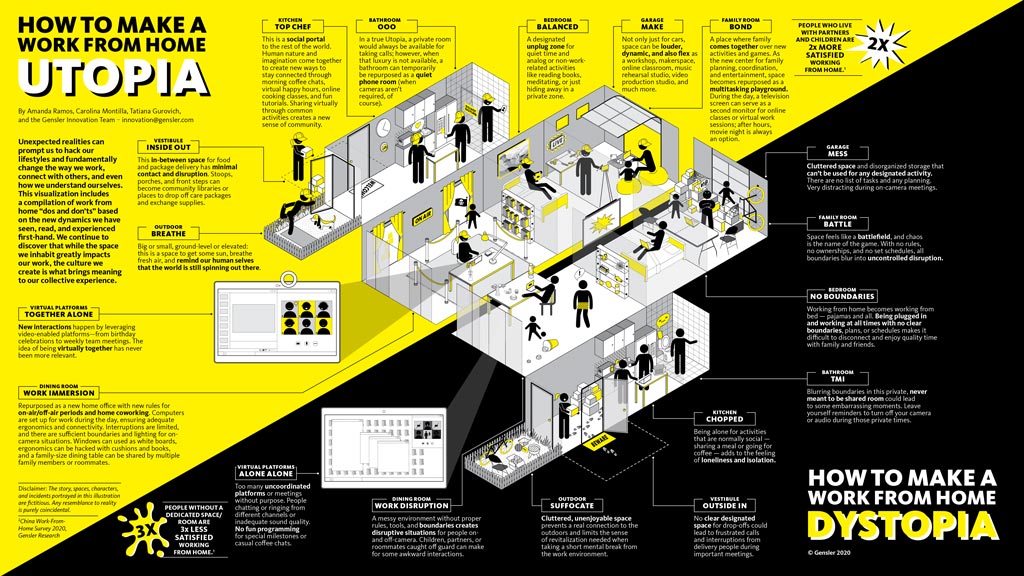How to Build Culture
in a Virtual World
March 26, 2020 | By Cindy Coleman and Amanda Ramos
Editor’s Note: This post is part of our ongoing exploration of how design is responding to the COVID-19 pandemic.
As COVID-19 causes the world to rethink the communal workplace, for businesses it’s also a philosophical and emotional assault on a company's culture.
According to a 2019 Glassdoor multi-country survey, 75% of employees pay close attention to a company’s culture before applying for a job. And 56% went further to say that culture is more important than salary. The workplace is essential to building culture. It is a place to connect, build trust, mentor, cultivate teams, build camaraderie, and share knowledge. Now, in the midst of a pandemic, where most everyone is working from home and meeting with each other virtually, company culture needs some love and attention.
In these rapidly changing times, it may be the small things that are the most useful for building and sustaining a connection to the organization’s mission, purpose, and ultimately each other. Shortly after our own firm went completely remote around the world, we asked our colleagues from the Workplace practice how other organizations can engage with employees virtually. Here are six key strategies from a collection of Gensler’s workplace and innovation leaders that can make significant impact on the remote work experience:
1. Embrace video interactions“Video conferencing is much more human when the camera is going,” says Cindy Coleman. In fact, the virtual space of the conference call can be its own productivity tool.
“There are 12 of us on the call,” Coleman notes. “We start out by saying hello and what’s on each person’s agenda for the day.” Afterwards, team leads are tasked with sending a follow-up email so that everyone is aware of key decisions and directions.
The daily rundowns, “have been helpful for us to connect daily,” adds Kevin Rosenstein. “We’re a tight group and need that sense of connectivity.”
Amanda Ramos adds a camera-on exception for our colleagues who suddenly find themselves homeschooling: “Parents are encouraged to stay on mute and turn off the camera if it alleviates any of the stress or concern that the children might curiously (and unexpectedly) chime in.”
2. Bring your empathy onlineAs our teams transitioned to remote work, setting aside time for regular check-ins was crucial from a strategic perspective — as well as a personal one.
“We set up a structure of one-on-ones over the next couple of weeks,” says Nayan Parekh. “Our senior staff is helping leadership by scheduling their own informal calls throughout the week.”
Collaboration tools and messaging apps can also be useful outside of work communications, says Elizabeth Brink. “Even if it’s just to say hello or send an emoji. It’s our virtual version of a meet-up at the water cooler.”
For leaders and managers, dialing up empathy is key in the virtual collaborative world, says Janet Pogue. “Some of your direct reports and particularly junior team members may be in far more challenging situations or personal circumstances,” she reminds us. “Always make sure to take this into consideration – showing true empathy and genuine care for the team is what sets great leaders apart.”
3. Keep creativity at the forefront“We started a web-based collaboration platform to share and store work in progress,” says Andrew Garnar-Wortzel, and in lieu of real-world whiteboards and pin-up spaces, virtual tools provide space for teams to come together and workshop ideas.
While video calling platforms often limit the collective voice, they can also provide an opportunity to “level the playing field,” says Gervais Tompkin. “By treating meetings more like workshops, you can deploy these platforms in a way that encourages 100% participation.”
“We do a ‘mental floss’ moment at least once a week,” says Arnold Levin. “It’s an opportunity for an employee to share a provocative idea.”
4. Stay healthy“Long periods of time working from home (alone), switching between one virtual platform to anothe
